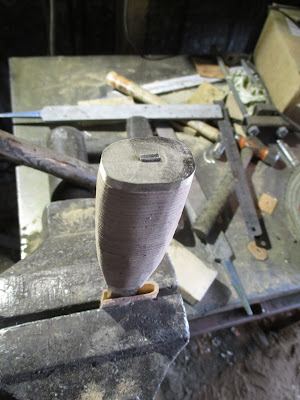I spent last weekend on Lake Inari again. This time with my girlfriend and the dogs Pyry and Kumu.
As a small dog Kumu can be pretty much where ever in the canoe, doesn't make much diffrence. Pyry being a medium sized dog, 24-25kg, would change the balance when moving around. So his place is usually right in front of me.
As you might have seen in my canoe trip post a while ago, this is pretty much what most of the scenery on Inari Lake is. Rocky, pine forests, and not that many summer houses. A nice real wilderness lake.
Paddling, fishing... No further plans for the trip. Again grayling, a common catch around the rocky islands.
Pyry waiting if there's more fish to come. An old dog knows what to expect....
We checked the open wilderness hut of Kahkusaari, and stayed overnight as well.
Yeah, that's cosy, right? Like there wouldn't be space anywhere else....
On Monday it was time to get back to work, so off to the bark handle making we go! Cutting the bark in appr 3x4cm flaps, cleaning them, making holes for the tang, piling them on the tang....
Bark squares are piled on the tang, tightened after every 2 to 4 flaps. Then the whole pile is tightened with a bit more power still, and few flaps more added. Sometimes it feels like it wouldn't tighten anymore, but waiting for a minute or two and then trying again it suddenly goes a bit more.
Tightly fitted rear plate is added, hammered on the tang, tang cut, and slightly peened. At this point the handle is 1,5 to 2 cm longer than the planned final length. Warming it up in a kitchen owen in 75 to 100 celcius for 45-60 mins makes the oil in the bark softer, so the final tightening get's easier.
Straight from the owen the blade is attached tightly on a vice, and the butt plate is forced down the tang with a hammer and wooden block. Planned length is appr. 11cm on this, so a bit more to go still. Tang needs to be shaped slightly tapered, so the brass plate will stay tigh all the way when forced on the tang. Proper fit of the tang and butt plate is the key for constructing a handle this way. If it gets loose, it means more work, but can be still done of course.
Tang is cut, and filed so it's just slightly above the butt plate. Then the same process as always with this kind of handle construction; take a ball-pein hammer, peen, file, peen, file....
Here's the result. No glue used, so you can start shaping and finishing the handle right away if you like.
Handles of this set roughly shaped on a belt sander, next moving to hand sanding. To be continued!













Looks like you had a nice and relaxing weekend. Always interesting to see the process on how the knives are made as well.
ReplyDeleteSure it was :-)
DeleteI can see my mini-leuku on the picture. ;-)
ReplyDeleteYes, there it is :-D
Delete